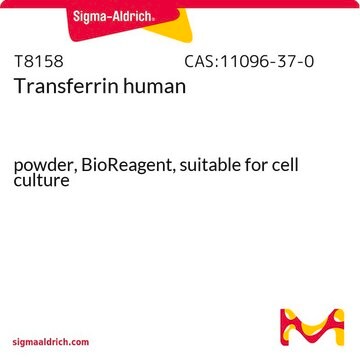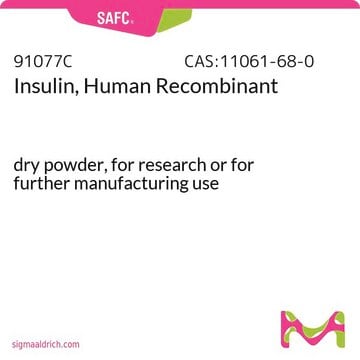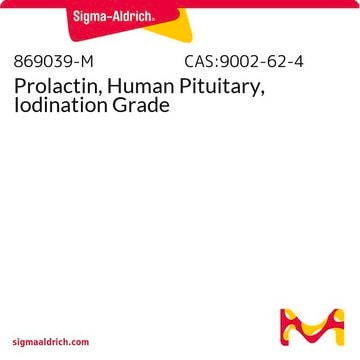L4021
Prolactin human
recombinant, expressed in E. coli, lyophilized powder, BioReagent, suitable for cell culture, >97% (SDS-PAGE)
Sinonimo/i:
hPRL, LTH, Lactogenic Hormone, Luteotropic Hormone, PRL
Scegli un formato
Scegli un formato
About This Item
Prodotti consigliati
Origine biologica
Escherichia coli
Livello qualitativo
Ricombinante
expressed in E. coli
Descrizione
200 amino acid residue methionyl form of mature, recombinant human prolactin (amino acid residues 29-227).
Nome Commerciale
BioReagent
Saggio
>97% (SDS-PAGE)
Stato
lyophilized powder
Potenza
0.030-0.300 ng/mL EC50
PM
predicted mol wt ~24 kDa
tecniche
cell culture | mammalian: suitable
Impurezze
endotoxin, tested
Solubilità
water: 0.5000 mL, clear, colorless
N° accesso UniProt
Condizioni di spedizione
ambient
Temperatura di conservazione
−20°C
Informazioni sul gene
human ... PRL(5617)
Applicazioni
Azioni biochim/fisiol
Altre note
Stato fisico
Ricostituzione
Risultati analitici
Avvertenze
Danger
Indicazioni di pericolo
Consigli di prudenza
Classi di pericolo
Repr. 1B
Codice della classe di stoccaggio
6.1C - Combustible acute toxic Cat.3 / toxic compounds or compounds which causing chronic effects
Classe di pericolosità dell'acqua (WGK)
WGK 3
Punto d’infiammabilità (°F)
Not applicable
Punto d’infiammabilità (°C)
Not applicable
Scegli una delle versioni più recenti:
Certificati d'analisi (COA)
Non trovi la versione di tuo interesse?
Se hai bisogno di una versione specifica, puoi cercare il certificato tramite il numero di lotto.
Possiedi già questo prodotto?
I documenti relativi ai prodotti acquistati recentemente sono disponibili nell’Archivio dei documenti.
I clienti hanno visto anche
Active Filters
Il team dei nostri ricercatori vanta grande esperienza in tutte le aree della ricerca quali Life Science, scienza dei materiali, sintesi chimica, cromatografia, discipline analitiche, ecc..
Contatta l'Assistenza Tecnica.









